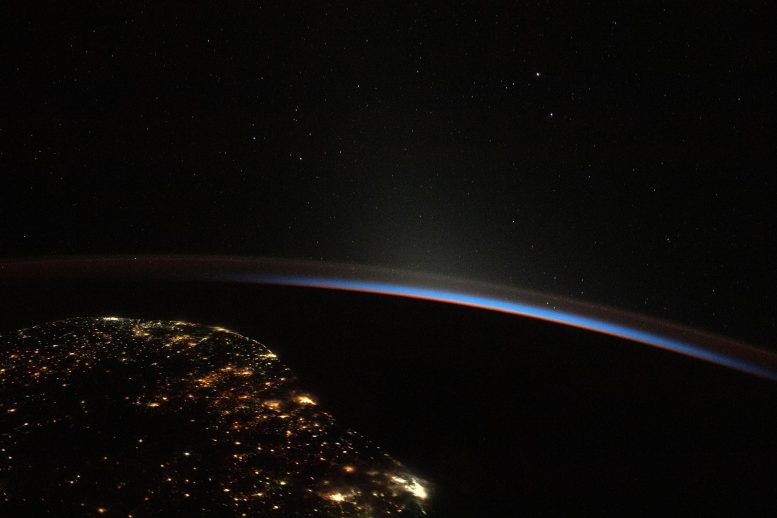
Photograph from International Space Station orbiting 263 miles above the southeast coast of Brazil on the Atlantic Ocean into an orbital sunrise. Credit: NASA
Night Turns to Day
The International Space Station was orbiting 263 miles (423 kilometers) above the southeast coast of Brazil on the Atlantic Ocean into an orbital sunrise when this photograph was taken.
The orbital platform has been continuously occupied for more than 20 years and hosts a variety of research and experiments that benefit the whole of humanity.
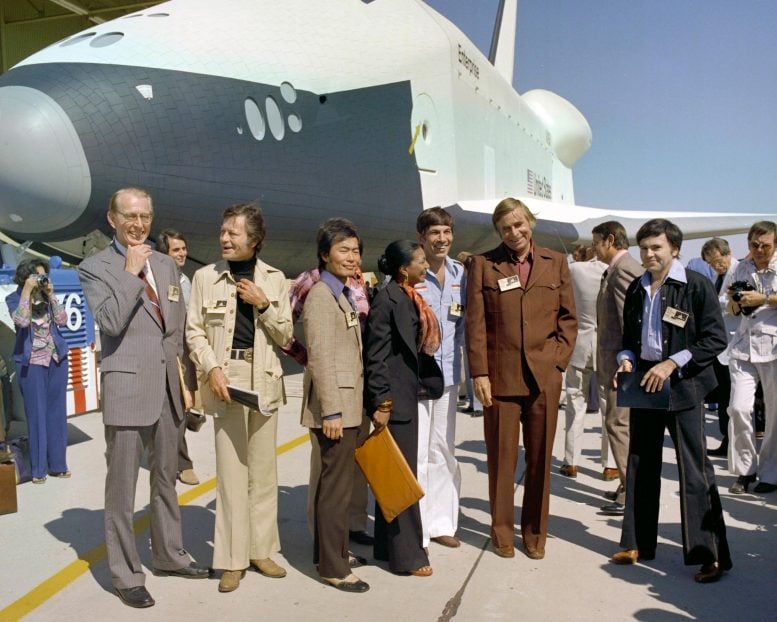
Dryden Flight Research Center (now Armstrong) hosted the Star Trek crew in 1976 for the rollout of space shuttle Enterprise. In front, from left: NASA Administrator James Fletcher, and the show’s stars DeForest Kelley, George Takei, Nichelle Nichols, Leonard Nimoy, show creator Gene Roddenberry, and Walter Koenig. Credit: NASA
Star Trek and NASA: Celebrating the Connection
Gene Roddenberry would have been 100 years old on August 19, 2021, and we at NASA celebrate his legacy. As creator of the legendary Star Trek saga, Roddenberry’s vision continues to resonate.
In the documentary “NASA on the Edge of Forever: Science in Space,” host NASA astronaut Victor Glover stated, “Science and Star Trek go hand-in-hand.” The film explores how for the past 55 years, Star Trek has influenced scientists, engineers, and even astronauts to reach beyond. While the International Space Station doesn’t speed through the galaxy like the Starship Enterprise, much of the research conducted aboard the orbiting facility is making the fiction of Star Trek come a little closer to reality.
In this image, the then Dryden Flight Research Center (now Armstrong) hosted the Star Trek crew in 1976 for the rollout of space shuttle Enterprise. In front, from left: NASA Administrator James Fletcher, and the show’s stars DeForest Kelley, George Takei, Nichelle Nichols, Leonard Nimoy, show creator Gene Roddenberry, and Walter Koenig.
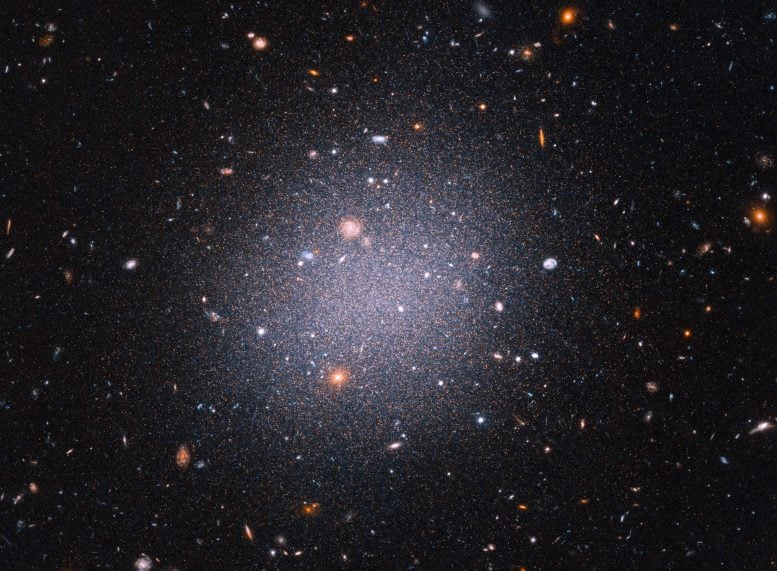
This Hubble Space Telescope snapshot reveals an unusual “see-through” galaxy. The giant cosmic cotton ball is so diffuse and its ancient stars so spread out that distant galaxies in the background can be seen through it. Called an ultra-diffuse galaxy, this galactic oddball is almost as wide as the Milky Way, but it contains only 1/200th the number of stars as our galaxy. Credit: Science: NASA, ESA, STScI, Zili Shen (Yale), Pieter van Dokkum (Yale), Shany Danieli (IAS) Image Processing: Alyssa Pagan (STScI)
A Ghostly Galaxy’s Lack of Dark Matter
Galaxies and dark matter go together like peanut butter and jelly. Rarely is one without the other, but a recently discovered galaxy called NGC 1052-DF2 is nearly entirely lacking in dark matter.
In November 2019, researchers were astonished when they viewed its image captured by the Hubble Space Telescope. Dark matter is an invisible substance that astronomers believe plays an important role in the formation of galaxies and is thought to comprise 85 percent of the universe’s mass. This discovery not only challenges the ideas of how galaxies form, but also provides evidence that dark matter is real. It shows that dark matter is not always coupled with regular matter in galaxies and that it has its own separate existence. In addition to lacking dark matter, galaxy NGC 1052-DF2 is an anomaly because you can see straight through it. This is called an ultra-diffuse galaxy because it has an extremely low density. As a result of these findings, a team of researchers are hunting for more dark-matter deficient galaxies to better understand the nature of dark matter and the formation of galaxies.
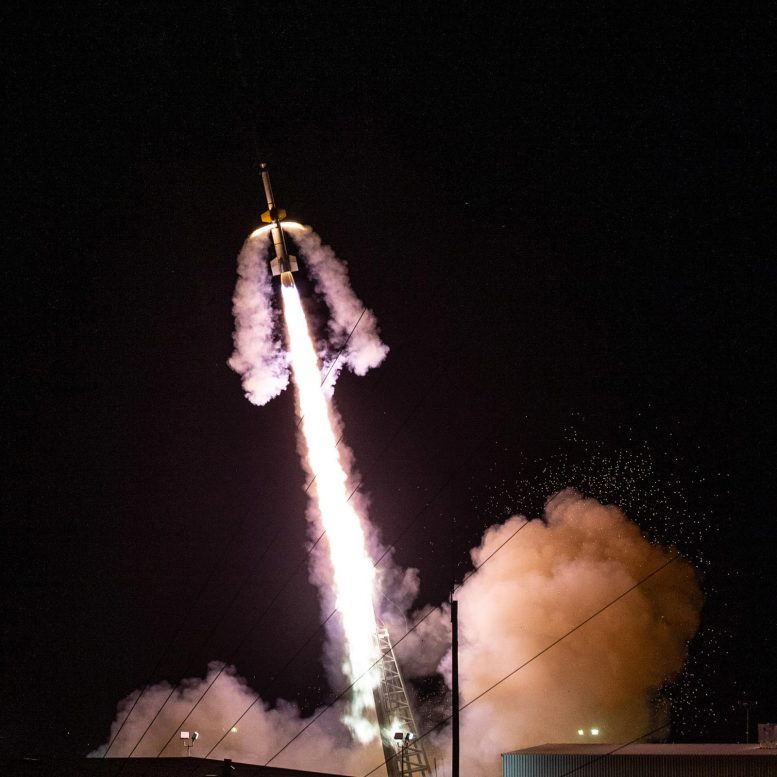
The NASA Black Brant XII rocket lifts off with the KiNET-X experiment at Wallops Flight Facility in Virginia, on Sunday, May 16, 2021. Credit: NASA Wallops/Terry Zaperach
Illuminating the Night Sky for Science
In this image, a NASA Black Brant XII suborbital sounding rocket was launched at 8:44 p.m. EDT, Sunday, May 16, 2021, from the Wallops Flight Facility.
The four stage rocket carried the KiNETic-scale energy and momentum transport eXperiment, or KiNet-X, designed to study a very fundamental problem in space plasmas, namely, how are energy and momentum transported between different regions of space that are magnetically connected.
These student-designed projects are a mix of technology and science experiments, including the development of a 360-degree camera for use on sounding rockets; space debris removal concepts; a solar array deployment system for CubeSats; and collection of particles in space for research on the origins of life.
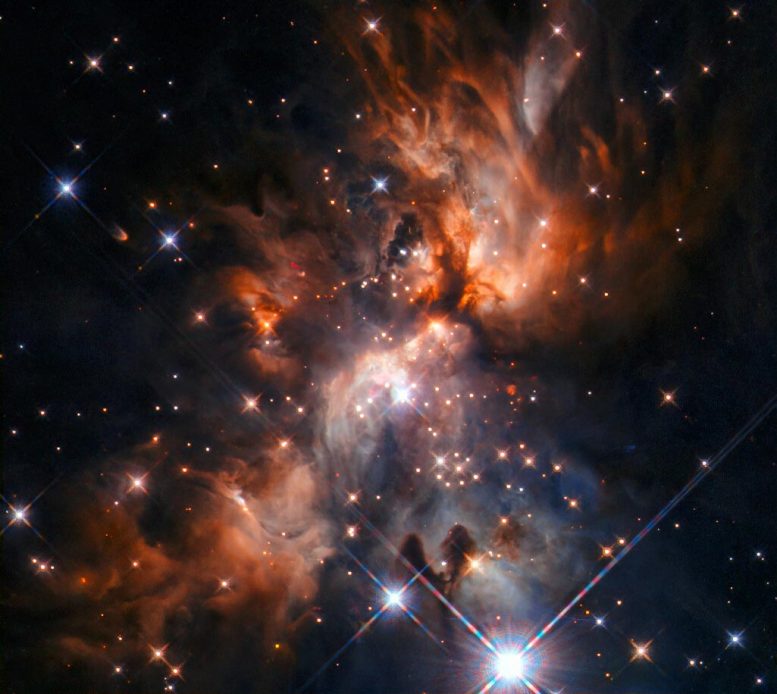
Credit: ESA/Hubble & NASA, J. C. Tan (Chalmers University & University of Virginia), R. Fedriani (Chalmers University)
Acknowledgment: Judy Schmidt
Star Formation in the Constellation of Gemini, the Twins
Nestled among the vast clouds of star-forming regions like this one lie potential clues about the formation of our own solar system.
This image from the NASA/ESA Hubble Space Telescope features AFGL 5180, a beautiful stellar nursery located in the constellation of Gemini (the Twins).
At the center of the image, a massive star is forming and blasting cavities through the clouds with a pair of powerful jets, extending to the top right and bottom left of the image. Light from this star is mostly escaping and reaching us by illuminating these cavities, like a lighthouse beacon piercing the storm clouds.
Stars are born in dusty environments and although this dust makes for spectacular images, it can prevent astronomers from seeing stars embedded in it. Hubble’s Wide Field Camera 3 (WFC3) instrument is designed to capture detailed images in both visible and infrared light, meaning that the young stars hidden in vast star-forming regions like AFGL 5180 can be seen much more clearly.



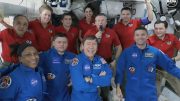




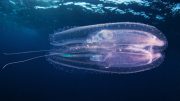
Be the first to comment on "NASA Images of the Week: Star Trek, Rocket Launch & a Ghostly Galaxy"